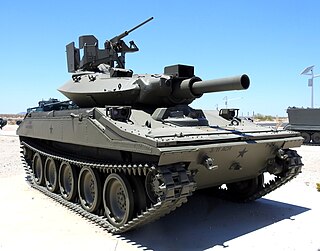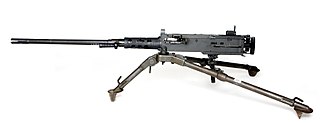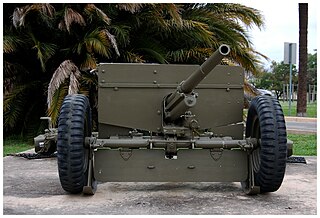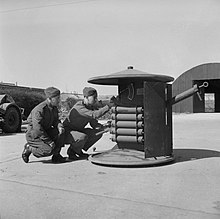
A tank destroyer, tank hunter or tank killer is a type of armoured fighting vehicle, predominantly intended for anti-tank duties. They are typically armed with a direct fire artillery gun, also known as a self-propelled anti-tank gun, or missile launcher, also called an anti-tank missile carrier. The vehicles are designed specifically to engage and destroy enemy tanks, often with limited operational capacities.

The M551 "Sheridan" AR/AAV was a light tank developed by the United States and named after General Philip Sheridan, of American Civil War fame. It was designed to be landed by parachute and to swim across rivers. It was armed with the technically advanced but troublesome M81/M81 Modified/M81E1 152 mm gun/launcher, which fired both conventional ammunition and the MGM-51 Shillelagh guided anti-tank missile.

The M2 machine gun or Browning .50 caliber machine gun is a heavy machine gun that was designed near the end of World War I by John Browning. While similar to Browning's M1919 Browning machine gun, which was chambered for the .30-06 cartridge, the M2 uses Browning's larger and more powerful .50 BMG cartridge. The design has had many designations; the official U.S. military designation for the infantry type is Browning Machine Gun, Cal. .50, M2, HB, Flexible. It has been used against infantry, light armored vehicles, watercraft, light fortifications, and low-flying aircraft.

The Bofors 40 mm Automatic Gun L/60 is an anti-aircraft autocannon, designed in the 1930s by the Swedish arms manufacturer AB Bofors. The gun was designed as an intermediate anti-aircraft gun, filling the gap between fast firing close-range small calibre anti-aircraft guns and slower firing long-range high calibre anti-aircraft guns. The Bofors 40 mm L/60 was for its time perfectly suited for this role and outperformed competing designs in the years leading up to World War II in both effectiveness and reliability.

The 90 mm gun M1/M2/M3 was an American heavy anti-aircraft and anti-tank gun, playing a role similar to the German 8.8cm Flak 18. It had a 3.5 in (90 mm) diameter bore, and a 50 caliber barrel, giving it a length of 15 ft (4.6 m). It was capable of firing a 3.5 in × 23.6 in shell 62,474 ft (19,042 m) horizontally, or a maximum altitude of 43,500 ft (13,300 m).

The Boys anti-tank rifle was a British anti-tank rifle used during the Second World War. It was often nicknamed the "elephant gun" by its users due to its size and large 0.55 in (14 mm) bore.

The Vickers 40 mm Class S gun, also known simply as the Vickers S or S gun, was a 40 mm (1.57 in) airborne autocannon designed by Vickers-Armstrongs for use as aircraft armament.

The Ordnance Quick-Firing 6-pounder 7 cwt, or just 6-pounder, was a British 57 mm gun, serving during the Second World War as a primary anti-tank gun of both the British and United States Army. It was also used as the main armament for a number of armoured fighting vehicles.

The Ordnance QF 2-pounder, or simply "2 pounder gun", was a 40 mm (1.575 in) British anti-tank gun and vehicle-mounted gun employed in the Second World War.

The Blacker Bombard, also known as the 29-mm Spigot Mortar, was an infantry anti-tank weapon devised by Lieutenant-Colonel Stewart Blacker in the early years of the Second World War.

The QF 3.7-inch AA was Britain's primary heavy anti-aircraft gun during World War II. It was roughly the equivalent of the German Flak 8.8 cm and American 90 mm, but with a slightly larger calibre of 3.7 inches, approximately 94 mm. Production began in 1937 and it was used throughout World War II in all theatres except the Eastern Front. It remained in use after the war until AA guns were replaced by guided missiles beginning in 1957.

The No. 73 grenade, also known as the "Thermos", "Woolworth bomb", or "hand percussion grenade", was a British anti-tank grenade used during the Second World War. It got its nickname from the resemblance to a Thermos flask.

The Oerlikon GDF or Oerlikon 35 mm twin cannon is a towed anti-aircraft gun made by Oerlikon Contraves. The system was originally designated 2 ZLA/353 ML but this was later changed to GDF-001. It was developed in the late 1950s and is used by around 30 countries.

The Projector, 2.5 inch—more commonly known as the Northover Projector—was an ad hoc anti-tank weapon used by the British Army and Home Guard during the Second World War.

The Flak 30 and improved Flak 38 were 20 mm anti-aircraft guns used by various German forces throughout World War II. It was not only the primary German light anti-aircraft gun but by far the most numerously produced German artillery piece throughout the war. It was produced in a variety of models, notably the Flakvierling 38 which combined four Flak 38 autocannons onto a single carriage.

The 37 mm gun M3 is the first dedicated anti-tank gun fielded by United States forces in numbers. Introduced in 1940, it became the standard anti-tank gun of the U.S. infantry with its size enabling it to be pulled by a jeep. However, the continuing improvement of German tanks quickly rendered the 37 mm ineffective and, by 1943, it was being gradually replaced in the European and Mediterranean theaters by the more powerful British-developed 57 mm gun M1. In the Pacific, where the Japanese tank threat was less significant, the M3 remained in service until the end of the war, but some 57mm guns were issued.

The L2 BAT was a 120 mm calibre recoilless anti-tank rifle used by the British Army. It was also produced in the MOBAT version without a gun shield, and the ConBAT version with a new spotting rifle attachment. The L6 Wombat version was greatly lightened through the use of magnesium alloys hence the name. The Wombat was used by mobile units such as paratroopers and marines. the Wombat was also issued to some TA battalions such as 5th Battalion, The Royal Anglian Regiment

The 76 mm gun M1 was an American World War II–era tank gun developed by the U.S United States Ordnance Department in 1942 to supplement the 75 mm gun on the basic Medium tank M4. It was also used to arm the M18 Hellcat tank destroyer.

A Z Battery was a short range anti-aircraft weapon system, launching 3 in (76 mm) diameter rockets from ground-based single and multiple launchers, for the air defence of Great Britain in the Second World War. The rocket motors were later adapted with a new warhead for air-to-ground use as the RP-3.




















